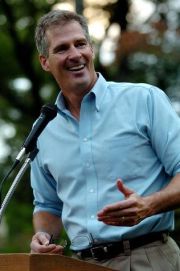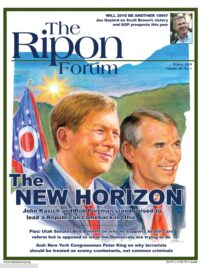 No two elections are alike. There are too many variables in play. The economy changes, the culture evolves, new leaders and new issues emerge.
No two elections are alike. There are too many variables in play. The economy changes, the culture evolves, new leaders and new issues emerge.
But I see three important similarities between the GOP’s status in 2010 and in 1994 when Republicans won control of Congress. I also see three differences, which are equally important.
The Similarities
Unusually unified. In both 1994 and 2010, the GOP quickly recovered from the disillusionment of losing a presidential election and forged a united front. Frankly, much of the credit for that unity should go to the Democrats. In both years, a Democratic president was polarizing and Democratic Congressional leaders were hyper-partisan. There’s nothing like fear of a common adversary to unite people.
Two months ago, when Republicans lost the U.S. House seat in New York’s 23rd district, Democrats hoped that it signaled the beginning of a civil war in the GOP. But the victory of Scott Brown in the special Senate election in Massachusetts dashed that hope. Brown ran a populist campaign, calling himself independent, and communicating a mix of conservative, moderate and nonpartisan positions. Yet all kinds of Republicans, from all over the country, rallied around him. We have not seen that kind of GOP unity and enthusiasm since Ronald Reagan.
“We have not seen that kind of GOP unity and enthusiasm since Ronald Reagan.”
Energized by conservative grassroots activism. The GOP leaders in Congress are usually “conservative” in taking action – they tend to be patient and gradual, rather than quick and aggressive. But conservative activists, demanding outright defeat of liberal schemes for more intrusive government, strengthen the resolve of GOP incumbents and help motivate GOP challengers. Listening to grassroots activists makes Republican leaders more responsive and in touch with public opinion, and thus more effective candidates – in contrast with Democratic incumbents afraid to hold “Town Hall meetings” or engage in debate.
Genuinely optimistic. In 1994, the unpopularity of a Democratic president and a Democratic controlled Congress helped convince GOP incumbents and challengers that the off-year election would be a great opportunity to gain seats. As a result, better challenger candidates were recruited, more money was raised, more volunteers got involved, and candidates acted with greater confidence. “Great expectations” can be self-fulfilling that way.
Recent elections have given us ample reason to be optimistic about GOP prospects in November. Republicans won resounding victories in three states that Barack Obama carried – governorships in Virginia and New Jersey, and the Senate race in Massachusetts. If a little-known Republican could come from 30 points behind in the polls to win the Senate seat formerly held by Ted Kennedy, the greatest icon of contemporary liberal Democrats, all things seem possible.
The Differences
Galvanizing Leadership. In 1994, House Republicans were fortunate to have a Teddy Roosevelt type of leader as a catalyst – a hard-charging reformer. That was Congressman Newt Gingrich of Georgia. His spirited challenges to Speakers Tip O’Neill, Jim Wright and Tom Foley inspired fellow Republicans to realize that being in the minority didn’t mean you had to be silent or acquiescent.
Equally important, he helped recruit good challenger candidates. Without credible challengers, of course, incumbents can’t be beaten. Gingrich not only gave these candidates hope and confidence, he also gave them an example. They adapted his rhetoric in making the case against the arrogance and corruption of one-party rule, and they adopted his attitude of being a “happy warrior.”
We don’t yet have a clear national GOP leader who is a catalyst in uniting our party, defining our reform message, and developing our campaign strategy. But we do have new leaders emerging – including those who won in New Jersey, Virginia and Massachusetts.
Alternative solutions. The GOP House candidates signed and campaigned on a platform of clear, compelling reforms, the “Contract with America.” This accomplished a number of things:
It nationalized House races – not allowing Democratic incumbents to get away with pretending in their districts to be all about constituent service and “bringing home the bacon” while voting for harmful liberal policies in DC. It also enabled GOP candidates to appeal to a larger percentage of voters than the 40 percent who call themselves conservative – offering ideas, like we promote at American Solutions, which appeal to 70-80 percent of voters. The “common sense reforms” in the “Contract with America” (e.g. “require all laws that apply to the rest of the country also apply equally to the Congress”) appealed to skeptical independents and disillusioned Democrats.
In 2010, the GOP has not done as well in convincing non-Republicans that it has alternative solutions to the radical proposals of Barack, Nancy and Harry. In the Massachusetts Senate race, Scott Brown gave us a good example. He made clear that he’d be the 41st vote against Obamacare, but he also said, “We can go back to the drawing board and do it better.”
He made clear that he favored sensible reforms – not a 2,000 page monstrosity that would make things worse.
“[Scott Brown] made clear that he’d be the 41st vote against Obamacare, but he also said, ‘We can go back to the drawing board and do it better.’”
Innovative challenger campaigns. In 1994, GOP challengers learned from GOPAC and National Republican Congressional Committee books and audiotapes that they needed to run campaigns which were opposite those of entrenched incumbents. They realized they needed five essential things to pull off an upset victory: creativity, capital, confidence, contrast, and controversy.
That new model for challengers led to a new kind of political entrepreneurship. Challenger campaigns were more aggressive, innovative and persuasive. Instead of being shy and overly polite, challengers drew bright lines of contrast with incumbents. Instead of talking like accountants, they spoke with the conviction of reform. Instead of wasting money on campaign overhead, they invested in persuasion. Instead of being fearful of the news media, they used imaginative tactics to create and sustain the kind of controversy that exposed out-of-touch incumbents.
In Massachusetts, Scott Brown was running for an open Senate seat against the state Attorney General, Martha Coakley. Yet he ran a challenger style campaign in the spirit of 1994. He ran against the arrogance, over-spending and corruption of the liberal Democratic establishment. And he forced his opponent to defend that establishment.
He had the confidence, capital, contrast, controversy and creativity to pull off an upset victory – the second “shot heard ‘round the world.”
The Prospects for this Fall
In 1994, Republicans had a net gain of 54 seats in the House and 8 in the Senate, taking majority control in both chambers.
This year Republicans should have major gains, as well, having the advantages of the three similarities with 1994: being unusually unified, being energized by conservative grassroots activism, and having the optimism that goes along with great expectations.
“This year Republicans should have major gains…”
But for Republicans to win enough seats to take control of both House and Senate, the GOP needs to work harder on the three things that are different from 1994: we need more GOP leaders who are galvanizing in a positive way; we need to offer clear and compelling alternative solutions, not just opposition to Democratic legislation; and finally, we need our challenger campaigns to be aggressive, innovative, reform-minded and persuasive.
Can we achieve the last three goals by November? With a little more help from the Democrats, I’m very optimistic.
–###–
Joseph R. Gaylord is CEO of American Solutions, a citizen action network of over 1.5 million members, chaired by Newt Gingrich. In the 1980s Gaylord was Executive Director of the National Republican Congressional Committee and then directed GOPAC, a political action committee credited with “the long campaign” that in 1994 resulted in the GOP takeover of the House.




